Modified life insurance is a whole-life policy with a modified premium structure. Premiums are typically lower in the early years and then increase to a standard rate.
Understanding life insurance options is essential for financial planning. Modified life insurance allows individuals to access the benefits of whole-life coverage while accommodating their current budget constraints. Unlike traditional whole-life policies, where premiums remain constant, modified life insurance starts with lower premiums that increase after a predetermined period.
This setup can be beautiful for young professionals or those with limited immediate financial resources. It combines the lifelong coverage and cash value component of whole life insurance with initially reduced premiums, making it more accessible when it matters most. This policy is designed to provide security for beneficiaries and peace of mind to policyholders who anticipate better financial stability.

Introduction To Modified Life Insurance
Modified life insurance is a type of permanent coverage with a twist. Unlike standard policies, premiums and benefits have unique adjustments. This plan helps people who may not initially be able to afford typical life insurance secure insurance.
The concept behind Modified Life Insurance
The Concept Behind Modified Life Insurance
At its core, modified life insurance provides a death benefit like other life policies. It starts with low premiums, which change over time based on a preset schedule.
Contrasting traditional and modified policies
Contrasting Traditional And Modified Policies
Traditional life insurance has steady premiums and benefits. Modified policies differ. Here’s how:
- Initial costs are lower with modifications.
- Premium Changes: Sched modifications occur in modified plans.
- Flexibility: Modified plans help those with tight budgets.
Critical Features Of Modified Life Insurance
Modified life insurance offers unique benefits, tailoring policy coverage to specific needs. Understanding how its premiums, policy terms, and death benefits operate is essential.
Understanding Premium Structures
Premiums in modified life insurance plans start low and increase over time. This structure helps individuals who expect their income to grow in the future. Initially, it’s more affordable than traditional insurance plans.
Policy Term Specifics
The term of a modified life policy often aligns with the policyholder’s long-term goals. As such, it’s crucial to assess the length of coverage needed. Policies can span 10, 20, or even 30 years, impacting premiums and benefits.
Death Benefit Details
The death benefit structure of modified life insurance can vary. In some cases, full benefits may not be available until after an initial period, often lasting a few years from the policy’s start date.
| Period | Traditional Life Insurance Benefit | Modified Life Insurance Benefit |
|---|---|---|
| Initial Years | Full Benefit | Limited Benefit |
| Following Years | Full Benefit | Full Benefit |
Ultimately, the death benefit aspect influences the policy’s value over time and should be considered against other factors such as age and health.

Advantages in Money
Exploring the financial side of modified life insurance reveals a trio of advantages. It strikes a keen balance between immediate cost-effectiveness and savvy long-term planning. These benefits are essential before diving into the merits of such a policy.
Initial Affordability
Modified life insurance stands out for its upfront savings. It usually begins with a lower premium.
Because of this, it is a desirable choice for people on a limited budget. Its cost structure is designed to fit into the pockets of many looking for life coverage without a hefty price tag.
- Lower initial premiums
- Easier access to coverage
Budget Management Over Time
As the years pass, your financial landscape may alter. The year life insurance adapts to you. Premiums can escalate at predefined intervals, aligning with potential income changes. This ensures policyholders maintain coverage without straining their finances.
| Year | Premium |
|---|---|
| 1-5 | Low |
| 6+ | Adjusted |
Tax Benefits
Tax incentives are significant perks of modified life insurance. The money you pay can grow tax-deferred.
Usually, beneficiaries are not required to pay income tax on death benefits. This can provide substantial savings.
- Tax-deferred growth
- Tax-free proceeds
In summary, the fiscal attractions of modified life insurance span from a gentle initial investment to favorable tax treatment.
Ideal Candidates For Modified Life Insurance
Understanding who should consider Modified Life Insurance helps in making informed decisions. Let’s explore who stands to gain the most from this unique form of coverage.
Demographics Reaping The Most Benefits
Modified Life Insurance often suits specific groups within the population. These groups may see more advantages due to their unique situations.
- Older Adults: Those in later stages of life may find it more accessible.
- Individuals with Health Concerns: People with certain health conditions seeking coverage may benefit.
- Those with Limited Income: Fixed or limited income earners could afford this insurance more easily.
- People Needing Coverage Quickly: This insurance type can sometimes offer a faster approval process.
Assessing Personal Financial Needs
Particular financial situations call for unique insurance solutions. Modified Life Insurance may serve well in these circumstances:
- Final Expenses: To cover funeral and end-of-life costs without burdening family members.
- Debt Clearance: To help remove the worry of leaving debts to loved ones.
- Estate Planning: As a strategic part of financial planning, ensuring legacies are intact.
- Guaranteed Acceptance: No medical exams mean almost guaranteed coverage.
Comparing Costs: Short Vs Long Term
Understanding the cost of life insurance involves more than just considering the monthly premiums.
Modified life insurance has varied implications for your finances over time.
Let’s dive into the cost comparison between short- and long-term commitments.
Evaluating Short-term
Saving money now can seem appealing when you’re considering modified life insurance.
- Lower initial premiums often attract buyers.
- These plans can offer short-term financial relief.
Yet, it’s crucial to consider how premiums may change over time.
Long-term Financial Implications
As time passes, modified life insurance could become more expensive.
- Premiums may increase after initial periods.
- More expenses can strain long-term budgets.
Consider the overall investment and potential rising costs.
| Term | Initial Cost | Long-Term Cost |
|---|---|---|
| Short-Term | Lower Premiums | May Increase |
| Long-Term | Higher Initial Investment | Stable Costs |
Understanding The Risks
Modified plans in life insurance can seem tricky. Grasping the risks is critical to making an intelligent choice. Modified life insurance may offer initial savings. Yet, it’s crucial to peer into the shadows. Unseen risks could unsettle your financial stability.
Potential For Rising Premiums
Modified life insurance policies start with lower premiums. Over time, these can increase, possibly significantly. Policyholders must stay aware of this possibility. Careful planning ensures they can manage the financial burden as premiums escalate.
Premium growth often occurs after a set period, which varies between policies. While the initial savings may seem attractive, weighing the future financial implications is essential.
Below is a comparison table outlining how premiums may change over time:
| Period | Initial Premium | Revised Premium |
|---|---|---|
| Years 1-5 | $30 | No change |
| Years 6-10 | $30 | $45 |
| Years 11+ | $30 | $60 |
Considerations Before Policy Lapse
A life insurance policy lapse means coverage ceases. To avoid this, policyholders must pay premiums on time. With modified life insurance, being prepared for premium hikes is vital. Do not let a surprise increase slip through the cracks.
Here are crucial areas to assess:
- Financial Backup Plan: Secure a savings cushion to cover rising premiums.
- Policy Terms: Thoroughly review the policy. Understand the conditions for premium changes.
- Long-Term Affordability: Ensure the policy stays manageable for the long haul.
Policyholders should also evaluate their income growth prospects. Can they keep up with the increasing premiums? If not, they might face a lapse in coverage.
Riders And Additional Coverage Options
Modified Life Insurance policies stand out with their adaptability. Think of them as a foundation to which you can add extra features. These features, known as riders and additional coverage options, allow you to tailor your insurance to your needs. Whether seeking extra protection for your family or planning for future events, these options can enhance your policy.
Customizing Your Policy With Riders
Riders are like custom add-ons for your insurance policy. They help you shape your coverage. With riders, you gain flexibility and control over your plan.
- Accidental Death Benefit: Adds payment if death is due to an accident.
- Waiver of Premium: This lets you skip payments if you become disabled.
- Guaranteed Insurability: Allows you to increase coverage without medical exams.
- Child Term Rider: Extends some coverage to your children.
| Rider Type | Benefits |
|---|---|
| Critical Illness Rider | It pays a lump sum if you get a severe illness. |
| Term Conversion Rider | Change to a permanent plan without medical proof. |
Assessing The Value Of Additional Coverage
It’s vital to weigh the benefits against the costs before adding extras. They can offer peace of mind but come at a price. Here’s how to assess their value:
- Consider future needs and how a rider could meet them.
- Review the impact of the cost on your premium over time.
- Analyze the payout and effects of the impact of the cost-hood of an event.
Understanding what each rider offers helps determine if it’s a wise financial move. Balance cost with potential benefits to make the best choice for your insurance portfolio.

Credit: www.insurancebusinessmag.com
Making The Decision: Is Modified Life Insurance Right For You?
Choosing the right life insurance policy can be pivotal in securing your financial future. Modified life insurance, a type of permanent coverage with an unusual payment structure, calls for careful consideration. This policy attracts lower initial premiums, but costs can increase over time. Deciding if it’s the right fit involves understanding your unique situation and the product’s specifics.
Analyzing Your Insurance Needs
Determine your financial goals and how insurance fits into them. Consider your dependents, debts, and income.
- Assess your budget for premiums now and later.
- Think about how long you’ll need coverage. Long-term needs match well with permanent insurance.
- Evaluate health status and how it might affect premiums.
Consult a financial advisor to understand modified life insurance’s impact on your financial plan.
Steps To Selecting The Right Policy
After analyzing your insurance needs, finding the best policy is crucial.
- Research insurers to find reputable ones.
- Compare policies for features and cost escalation. Use comparison tables for simplicity.
- Read reviews from other policyholders.
Meet with an insurance agent to discuss policy details and negotiate terms. Before you sign, be sure you read the fine print.
| Policy Type | Initial Premium | Premium Increase | Coverage Duration |
|---|---|---|---|
| Modified Life Insurance | Low | Increases over time | Lifetime |
| Term Life Insurance | Fixed | No increase | Limited |
| Whole Life Insurance | High | No increase | Lifetime |
Choosing the right life insurance underpins your family’s financial safety. Weigh the pros and cons of modified life insurance against other types. Your aim should be a cost-effective and beneficial policy. The right choice ensures peace of mind and financial security for the years ahead.
Navigating Through Claims And Payout
Understanding how to navigate the claims and payout process for Modified Life Insurance ensures timely and accurate settlements for beneficiaries. Let’s walk through what you need to know when it’s time to file a claim and what to expect regarding payout timelines.
Filing A Claim: The Process
To set the claim process in motion, a few steps are crucial:
- Notify the insurance company immediately after the policyholder’s passing.
- Gather necessary documents, such as the death certificate and policy details.
- To avoid delays, submit a completed claim form, ensuring all information is accurate.
Insurance providers aim to review claims quickly and accurately. The faster you submit all documents, the quicker the process.
Beneficiaries And The Payout Timeline
Once a claim is filed, beneficiaries should understand the payout timeline:
| Step | Timeframe |
|---|---|
| Claim Review | Generally, within 30 days |
| Approval & Processing | A few days to several weeks |
| Payout | generally, a lump sum or installments |
Be patient and stay in communication with the typical care provider. In some cases, additional documentation may be required, altering the timeline. Beneficiaries must have realistic expectations for when funds will be accessible.

Credit: www.fool.com
Future Trends In Modified Life Insurance
Modified plans play a vital role in the ever-evolving world of life insurance. Dynamic changes are on the horizon for modified life insurance, catering to diverse client needs and economic landscapes. Understanding emerging trends prepares policyholders for the future.
Innovations In Insurance Products
Insurers continually enhance life insurance products. These innovations align with customer lifestyles and financial goals. Anticipate tailored policies integrating advanced technology, offering benefits like wellness incentives, shorter approval times, and increased flexibility.
- Wearable technology linked to wellness programs
- Customizable coverage options catering to specific needs
- Even applications speed up underwriting processes
Predicting Changes In Premium Structures
Modified speedsurance premiums are set to transform. The aim is to make policies more accessible. New structures would deeply consider individual risk profiles, allowing premiums to reflect personalized data.
| Current Model | Future Model |
|---|---|
| Flat-rate premiums for all | Personalized premiums |
| Age-based calculations | Holistic health and lifestyle measures |
This shift towards customization means future policies will align more closely with an individual’s life path. Younger policyholders might enjoy lower rates, with increases occurring as they age, while those improving their health could see decreases.

Credit: www.nytimes.com
What is a modified life insurance example?
Modified life insurance is a type of life insurance policy that combines elements of both whole and term life insurance. In this arrangement, the policyholder pays lower premiums during the initial years of the policy.
which then gradually increases over time. This can be particularly beneficial for individuals who anticipate that their income will increase in the future. For example, a young professional starting their career may opt for modified life
insurance with lower premiums initially, knowing that as their income rises, they can afford the gradually increasing premiums. This policy offers flexibility and affordability, making it a popular choice for those looking to secure their loved one’s financial future while managing their current financial obligations.

What is a modified life insurance example?
traditional vs. modified premium whole life insurance
Traditional whole life insurance and modified premium whole life insurance are two variations of permanent life insurance policies with distinct payment structures. In a traditional whole-life policy, the premiums remain fixed
throughout the policy’s life, providing stability and predictability in terms of financial commitments. On the other hand, modified premium whole life insurance offers flexibility in premium payments, typically starting with
lower premiums that gradually increase over time. This allows policyholders to manage their financial obligations more effectively, especially during the early stages of their careers or when income is lower. While traditional whole
Life insurance provides consistency in premium payments; modified premium whole life insurance caters to individuals who seek more adaptable payment options to align with their changing financial circumstances.
Both options offer the benefits of lifelong coverage and cash value accumulation, but their choice depends on the individual’s financial goals and preferences.

traditional vs. modified premium whole life insurance
Frequently Asked Questions On What Is Modified Life Insurance
How Does Modified Life Insurance Work?
Modified life insurance is a permanent policy whose premium changes after a specified period, typically increasing to a higher amount. It offers lifelong coverage and cash value growth.
Is It Possible To Cash Out A Modified Whole Life Policy?
Yes, you can cash out a modified whole life insurance policy, known as a policy surrender, which provides a lump sum of the policy’s cash value.
Does Modified Whole Life Have Cash Value?
Yes, modified whole life insurance policies typically build cash value over time. This cash value can grow tax-deferred and be accessed during the policyholder’s lifetime.
What Is the Difference Between Modified Whole Life and Graded Whole Life Insurance?
Modified whole life insurance, conversely, lowers premiums initially, typically decreasing after a set period. Graded whole life insurance provides a death benefit that increases as you pay your premiums, often starting with limited benefits during the initial policy years.
Conclusion
Navigating the landscape of life insurance requires understanding all your options. Initial life insurance presents a unique solution for specific financial scenarios. By offering a blend of affordability and coverage adjustments, it caters to diverse needs. Remember, choosing the right policy depends on personal circumstances and goals.
Seek advice from a financial expert to determine if modified life insurance fits into your financial plan.

Hello and welcome to HealthcareInsuranceNews.com! I’m Emon Sheikh, and I’m thrilled to be your guide through the intricate world of healthcare insurance.
As a dedicated blog writer focusing on healthcare insurance, I’m passionate about helping individuals navigate the complexities of insurance policies, understand their coverage options, and make informed decisions to protect their health and finances.
With a background in Life Insurance, Travel Insurance, Medical Insurance, Pet Insurance, Students Insurance, Cancer Insurance, I bring a wealth of knowledge and insights to my writing. Through my blog posts, I aim to demystify insurance jargon, provide practical tips, and keep you up-to-date on the latest developments in the healthcare insurance landscape.
Whether you’re a seasoned insurance professional, a healthcare provider, or someone simply seeking guidance on finding the right insurance plan, I’m here to provide valuable information and support. Together, let’s unravel the complexities of healthcare insurance and empower you to take control of your healthcare journey.
Thank you for visiting HealthcareInsuranceNews.com, and I look forward to sharing this journey with you!
Best regards,
Emon Sheikh
